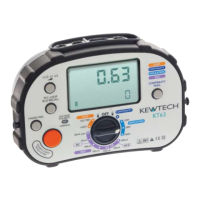kewtechcorp.com
15
kewtechcorp.com
Loop test functions
Caution
Although fully protected against over voltage to 440V this tester should only be used on a
230V supply
Important note for calibration check box users: The smart loop test system used by the KT63
is immune to sudden high value changes such as voltage spikes. As a result when changing
calibration or check box loop values the tester or the supply must be switched off between
changes
Over temperature. If this symbol shows in the display the temperature of the unit has
reached a point where the performance accuracy could not be guaranteed. Allow the
tester to cool down before proceeding
The KT63 Loop test function has 2 modes for Loop testing that allow the user to conduct the
most accurate test possible whether or not the circuit under test is protected by an RCD.
High Current mode
For Ze testing at the distribution board or at any point upstream of RCD protection there is
a traditional fast high current test mode. The high current mode is a 2-wire test that enables
the user to test the true impedance of both the Line-Neutral Loop and the Line–Earth Loop
and therefore to establish both the PSC (prospective short circuit current) and the PFC
(prospective fault current) for the installation.
Unlike most testers that only measure the resistance of the Loop, the high current mode
of the KT63 will measure the true Impedance of the Loop which includes an element of
reactance. This can be significant where the distribution board is close to the mains supply
transformer and is therefore much more accurate than older Loop testing techniques.
You should be aware that because of this there may well be variations in readings compared
to ordinary loop testers or to the no-trip function of this tester, particularly when the
measurement is made near to the mains supply transformer.
No Trip Mode
For Zs testing where the circuit being tested is protected by an RCD there is the new NTL (No
Trip Loop) mode. In this mode testing can be made at sockets on the final circuit without fear
of tripping the RCD.
This is achieved by testing at a current that is too low to trip an RCD on an otherwise
healthy circuit.* The No Trip test is a 3-wire test that also checks the Live, Neutral / Earth
conductors are correctly connected before running the loop test.
Whilst No-Trip testing at points on the final circuit will normally function with a high level of
accuracy, it should be noted that the low current measurement technique used is more likely
to be adversely affected by external factors.
Circumstances such as testing at seldom used socket outlets with tarnished contacts or
testing a circuit with a lot of background noise from electronic apparatus can result in the
occasional erroneous reading.
For this reason it is recommended that multiple measurements are made when using the No-
trip mode and any isolated odd results are ignored. When taking multiple readings the tester
should be disconnected from the supply between consecutive tests
For safety reasons the No-Trip mode is recommended for all measurements made on TT
systems.
* Where practical all other equipment powered by the same circuit should be switched off
before testing. This will reduce the chances of the RCD tripping as a result of combined
leakages.
PFC/PSC
In both Loop test modes the KT63 will also display the supply voltage and at the touch of the
PFC button the PFC/PSC will be displayed.
Test lead configuration
The KT63 Loop test function can be used with 2 different types of connecting lead. It is
important to understand and use the correct lead configuration for each test mode or you
may not obtain the correct results.
Lead options
1 Ref: KAMP12 The mains lead with 3 x 4mm plug to 13A plug
2 Ref: ACC063 The 3-Pole distribution board test lead set that can be fitted with either prod
tips or crocodile clips as required.
The lead is an integral part of the tester set-up and should accompany the tester when being
returned for re-calibration or service. Do not use any other type of mains lead or test lead set.

